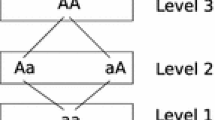Abstract
The main problem addressed in this paper is the merging of numerical information provided by several sources (databases, experts...). Merging pieces of information into an interpretable and useful format is a tricky task even when an information fusion method is chosen. Fusion results may not be in suitable form for being used in decision analysis. This is generally due to the fact that information sources are heterogeneous and provide inconsistent information, which may lead to imprecise results. In this paper, we propose the use of Formal Concept Analysis and more specifically pattern structures for organizing the results of fusion methods. This allows us to associate any subset of sources with its information fusion result. Once a fusion operator is chosen, a concept lattice is built. With examples throughout this paper, we show that this concept lattice gives an interesting classification of fusion results. When the fusion global result is too imprecise, the method enables the users to identify what maximal subset of sources that would support a more precise and useful result. Instead of providing a unique fusion result, the method yields a structured view of partial results labelled by subsets of sources. Finally, an experiment on a real-world application has been carried out for decision aid in agricultural practices.
Access this chapter
Tax calculation will be finalised at checkout
Purchases are for personal use only
Preview
Unable to display preview. Download preview PDF.
Similar content being viewed by others
References
Bloch, I., Hunter, A., Ayoun, A., Benferhat, S., Besnard, P., Cholvy, L., Cooke, R., Dubois, D., Fargier, H.: Fusion: general concepts and characteristics. International Journal of Intelligent Systems 16, 1107–1134 (2001)
Dubois, D., Prade, H.: Possibility theory and data fusion in poorly informed environments. Control Eng. Practice 2, 811–823 (1994)
Dubois, D., Lang, J., Prade, H.: Dealing with multi-source information in possibilistic logic. In: European Conference on Artificial Intelligence, pp. 38–42 (1992)
Dubois, D., Prade, H.: Possibility theory in information fusion. In: Data fusion and Perception, pp. 53–76 (2001)
Benferhat, S., Dubois, D., Prade, H.: Reasoning in inconsistent stratified knowledge bases. In: Int. Symp. on Multiple-Valued Logic, pp. 184–189 (1996)
Chaudron, L., Maille, N.: Le modèle des cubes: représentation algébrique des conjonctions de propriétés. In: Reconnaissance des Formes et Intelligence Artificielle, RFIA (2000) (in French)
Phan-Luong, V.: A framework for integrating information sources under lattice structure. Information Fusion 9(2), 278–292 (2008)
Dubois, D., Fargier, H., Prade, H.: Multiple source information fusion: a practical inconsistency tolerant approach. In: IPMU, pp. 1047–1054 (2000)
Destercke, S., Dubois, D., Chojnacki, E.: Possibilistic information fusion using maximal coherent subsets. IEEE Transactions on Fuzzy Systems 17, 79–92 (2009)
Rescher, N., Manor, R.: On inference from inconsistent premisses. Theory and Decision 1, 179–217 (1970)
Malouf, R.: Maximal consistent subsets. Comput. Linguist. 33(2), 153–160 (2007)
Assaghir, Z., Girardin, P., Napoli, A.: Fuzzy logic approach to represent and propagate imprecision in agri-environmental indicator assessment. In: IFSA/EUSFLAT Conf., pp. 707–712 (2009)
Ganter, B., Wille, R.: Formal Concept Analysis. Springer, Heidelberg (1999)
Ganter, B., Kuznetsov, S.O.: Pattern Structures and Their Projections. In: Delugach, H.S., Stumme, G. (eds.) ICCS 2001. LNCS (LNAI), vol. 2120, pp. 129–142. Springer, Heidelberg (2001)
Kaytoue, M., Duplessis, S., Kuznetsov, S.O., Napoli, A.: Two FCA-Based Methods for Mining Gene Expression Data. In: Formal Concept Analysis. LNCS, vol. 5548. Springer, Heidelberg (2009)
Chaudron, L., Maille, N.: Generalized formal concept analysis. In: Ganter, B., Mineau, G.W. (eds.) ICCS 2000. LNCS, vol. 1867, pp. 357–370. Springer, Heidelberg (2000)
Kuznetsov, S.O., Obiedkov, S.A.: Comparing Performance of Algorithms for Generating Concept Lattices. J. Exp. Theor. Artif. Intell. 14, 189–216 (2002)
Van der Werf, H., Zimmer, C.: An indicator of pesticide environmental impact based on a fuzzy expert system. Chemosphere 36(10), 2225–2249 (1998)
Bockstaller, C., Girardin, P., Van Der Werf, H.: Use of agro-ecological indicators for the evaluation of farming systems. European Journal of Agronomy 7(1-3) (1997)
Baer, U., Calvet, R.: Fate of Soil Applied Herbicides: Experimental Data and Prediction of Dissipation Kinetics. J. Environ. Qual. 28(6), 1765–1777 (1999)
Assaghir, Z., Kaytoue, M., Prade, H.: A possibility theory-oriented discussion of conceptual pattern structures. In: Int. Conf. on Scalable Uncertainty Management (SUM). LNCS. Springer, Heidelberg (2010)
Author information
Authors and Affiliations
Editor information
Editors and Affiliations
Rights and permissions
Copyright information
© 2010 Springer-Verlag Berlin Heidelberg
About this paper
Cite this paper
Assaghir, Z., Kaytoue, M., Napoli, A., Prade, H. (2010). Managing Information Fusion with Formal Concept Analysis. In: Torra, V., Narukawa, Y., Daumas, M. (eds) Modeling Decisions for Artificial Intelligence. MDAI 2010. Lecture Notes in Computer Science(), vol 6408. Springer, Berlin, Heidelberg. https://doi.org/10.1007/978-3-642-16292-3_12
Download citation
DOI: https://doi.org/10.1007/978-3-642-16292-3_12
Publisher Name: Springer, Berlin, Heidelberg
Print ISBN: 978-3-642-16291-6
Online ISBN: 978-3-642-16292-3
eBook Packages: Computer ScienceComputer Science (R0)




